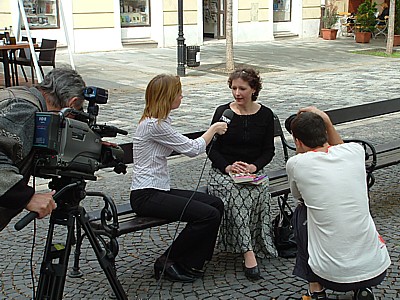
Local public access TV stations may be the best kept secret in America. Where else can you get free access to training, equipment, support and the local airwaves all in one location? For small businesses, local access TV is an opportunity to produce your own TV show, become known in the community and build your reputation as an expert in your field. Local access or community media, is also known as “PEG” access, as in:
1. Public – Stations open to the community for local programming
2. Educational – Stations dedicated to educational or school-related programming
3. Government – Government access channels for town meetings and city business
It’s the “public” channel that offers the most potential, and here’s how to maximize it:
Check your local listings
Not every town has all three “PEG” outlets, but with over 3,000 community media centers across the country, chances are there’s one near you. Check your town’s Web site or contact your town hall. Another misconception: You do not necessarily have to live in the town to utilize their community access station. Most access centers are eager for new producers and new programs. FYI: The Alliance for Community Media is a national, non-profit organization that promotes and supports public access TV. They maintain an extensive database and links to local access centers. Look for your town there.
Get free training
Most community media access centers provide frequent producer orientations, equipment training and studio instruction. The focus is typically on getting you up and running in one or two sessions. Volunteers and producers are the life blood of public access, so you’ll find plenty of accommodating help.
Go make TV!
As long as you’re armed with an idea, you’re ready to produce a show. If you’re not quite ready for your close up, start by assisting with another show, or by being a guest on another’s producer’s program. There’s no shortage of opportunities in front or behind the camera, so just dive in. The Alliance for Community Media’s online bookstore also features books and videos for additional training or inspiration.
Fix it in post
You can produce your program “live to tape,” if you’re doing a talk show or just want to do your show “on the fly.” In most cases, you’re probably going to want to edit your tape. Post production is where you can make your program look more professional by editing mistakes, inserting graphics or adding music. Most home computers now include basic editing or movie-making software, and those starter programs are relatively easy to master. iMovie is ideal if you’re on a Mac; Windows Movie Maker is adequate if you’re on a PC platform. When you’re ready for more professional editing, bump up to Final Cut Pro for the Mac or Adobe Premiere for the PC.
Promote and distribute
Once your show is complete, find out from your public access station when it’s going to air so you can promote your premiere! You may find that they run it several time per week. In addition to the local airing, you should definitely consider expanding your distribution. One way to extend your reach is to ask your channel to “bicycle,” or share your show with other access centers. A more direct approach is to upload your show to free video hosting sites such as YouTube or VideoEgg.com. Most video sites restrict uploads by file size (100MB) or length. Yo go beyond the obvious sites like YouTube and Google Video, and upload your video (or shorter clips) to Blip.tv and Veoh.com. These are very-user friendly, free video hosting sites with lots of great features.
Here are a few more suggestions to keep in mind:
• Public Access TV need not be cheesy. The technology and equipment have come a long way – so take advantage of the resources available.
• Expand your video from local public access to the Internet. Web users are downloading 7 billion videos per month!
• Be sure to save your video as an electronic file for the web, such as a Quicktime movie (.mov), or a Windows movie (.wmv). After you upload your video, many video sites will provide the HTML code so you can embed your video on your own website.
• A study by the Wharton School of Business reports that video can be 600% more effective in communicating a message than print. Tap into that power!
 Lou Bortone is an award-winning writer and video producer with over 20 years experience in marketing, branding and promotion. As an online video expert, Lou helps entrepreneurs create video for the web at www.TheOnlineVideoGuy.com. In addition, Lou works as a freelance writer and professional ghostwriter, with a ghostwriting site at www.GhostwriteForYou.com and a blog at www.GhostwriteGuru.com.
Lou Bortone is an award-winning writer and video producer with over 20 years experience in marketing, branding and promotion. As an online video expert, Lou helps entrepreneurs create video for the web at www.TheOnlineVideoGuy.com. In addition, Lou works as a freelance writer and professional ghostwriter, with a ghostwriting site at www.GhostwriteForYou.com and a blog at www.GhostwriteGuru.com.
Tag: publicity
Great Low-Cost PR Tactics

Public relations can be an effective way to generate awareness and name recognition for your business. PR is also considered to be a low-cost alternative to other marketing tactics such as traditional advertising and media buying. Your PR strategy should begin with the following key elements:
1. Build your target list: Compile an accurate database of key media contacts.
2. Develop your hook: Tell a compelling story.
3. Follow up: Cultivate relationships with the media and stay in touch.
Following are five steps to help you get good PR:
1. Turbo-charge your press releases
Your news releases should be newsworthy, targeted to the appropriate contact and, above all, engaging. Break through the clutter by enclosing something unique or creative (related to your business) with your release.
2. Maximize email marketing
Email marketing software has made it easier than ever to send out professional newsletters and press releases. User-friendly templates let you customize, target and track your email releases. It’s a low-cost way to stay top-of-mind with the media. Constant Contact offers low-cost do-it-yourself email marketing solutions, as do Bronto and Benchmark Email.
3. Make the media’s job easier
Tailor your pitch to the appropriate writer or reporter. If you’re not sure who to send your release to, call the newspaper, magazine, TV or radio station first and ask. Respect their time and deadlines. Have a press kit ready if the media ask for more info, but don’t flood them with sales materials. Give them what they need, when they need it, and you’ll increase your chances for positive press coverage.
4. Develop relationships with press contacts
Network with the media at industry events. Make an effort to get to know local reporters and leverage those relationships. Establish yourself as a resource to reporters and editors. Need to find reporters or editors? Burrells,Luce Media Contacts database lists 300,000 contacts at 60,000 media outlets (fees vary). Or use Google News to search for news articles with the name of your company, your competitors or your industry, as a way to build a list of names of reporters.
5. Start a blog
Establishing a company blog is low-cost way to position your business as a leader and an expert in your field. You can then direct the media to your blog and include the URL in your press releases and emails. Blogger and WordPress are free, easy-to-use blog publishing tool that can have you up and blogging in minutes. An alternate, low-cost blog publishing site is TypePad.
If you work to become a reliable and trusted source to the media – and if you provide them with real news – they will put you and your business in a positive light.
 Lou Bortone is an award-winning writer and video producer with over 20 years experience in marketing, branding and promotion. As an online video expert, Lou helps entrepreneurs create video for the web at www.TheOnlineVideoGuy.com. In addition, Lou works as a freelance writer and professional ghostwriter, with a ghostwriting site at www.GhostwriteForYou.com and a blog at www.GhostwriteGuru.com.
Lou Bortone is an award-winning writer and video producer with over 20 years experience in marketing, branding and promotion. As an online video expert, Lou helps entrepreneurs create video for the web at www.TheOnlineVideoGuy.com. In addition, Lou works as a freelance writer and professional ghostwriter, with a ghostwriting site at www.GhostwriteForYou.com and a blog at www.GhostwriteGuru.com.